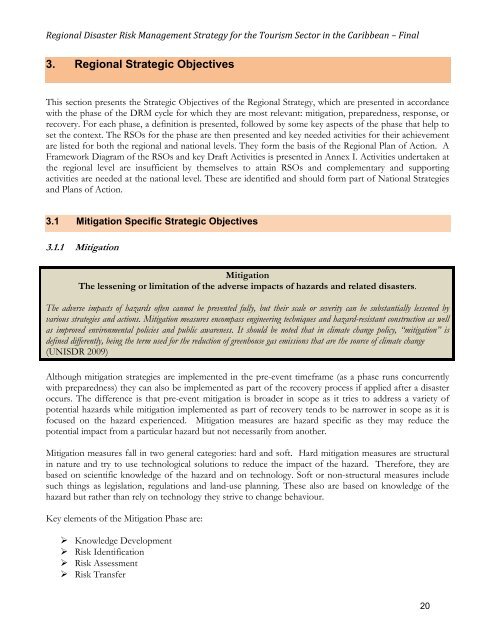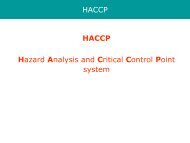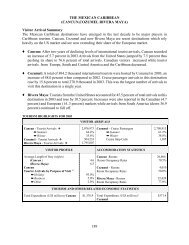Disaster Risk Management Strategy and Plan of Action - Caribbean ...
Disaster Risk Management Strategy and Plan of Action - Caribbean ...
Disaster Risk Management Strategy and Plan of Action - Caribbean ...
Create successful ePaper yourself
Turn your PDF publications into a flip-book with our unique Google optimized e-Paper software.
Regional <strong>Disaster</strong> <strong>Risk</strong> <strong>Management</strong> <strong>Strategy</strong> for the Tourism Sector in the <strong>Caribbean</strong> – Final<br />
3. Regional Strategic Objectives<br />
This section presents the Strategic Objectives <strong>of</strong> the Regional <strong>Strategy</strong>, which are presented in accordance<br />
with the phase <strong>of</strong> the DRM cycle for which they are most relevant: mitigation, preparedness, response, or<br />
recovery. For each phase, a definition is presented, followed by some key aspects <strong>of</strong> the phase that help to<br />
set the context. The RSOs for the phase are then presented <strong>and</strong> key needed activities for their achievement<br />
are listed for both the regional <strong>and</strong> national levels. They form the basis <strong>of</strong> the Regional <strong>Plan</strong> <strong>of</strong> <strong>Action</strong>. A<br />
Framework Diagram <strong>of</strong> the RSOs <strong>and</strong> key Draft Activities is presented in Annex I. Activities undertaken at<br />
the regional level are insufficient by themselves to attain RSOs <strong>and</strong> complementary <strong>and</strong> supporting<br />
activities are needed at the national level. These are identified <strong>and</strong> should form part <strong>of</strong> National Strategies<br />
<strong>and</strong> <strong>Plan</strong>s <strong>of</strong> <strong>Action</strong>.<br />
3.1 Mitigation Specific Strategic Objectives<br />
3.1.1 Mitigation<br />
Mitigation<br />
The lessening or limitation <strong>of</strong> the adverse impacts <strong>of</strong> hazards <strong>and</strong> related disasters.<br />
The adverse impacts <strong>of</strong> hazards <strong>of</strong>ten cannot be prevented fully, but their scale or severity can be substantially lessened by<br />
various strategies <strong>and</strong> actions. Mitigation measures encompass engineering techniques <strong>and</strong> hazard-resistant construction as well<br />
as improved environmental policies <strong>and</strong> public awareness. It should be noted that in climate change policy, “mitigation” is<br />
defined differently, being the term used for the reduction <strong>of</strong> greenhouse gas emissions that are the source <strong>of</strong> climate change<br />
(UNISDR 2009)<br />
Although mitigation strategies are implemented in the pre-event timeframe (as a phase runs concurrently<br />
with preparedness) they can also be implemented as part <strong>of</strong> the recovery process if applied after a disaster<br />
occurs. The difference is that pre-event mitigation is broader in scope as it tries to address a variety <strong>of</strong><br />
potential hazards while mitigation implemented as part <strong>of</strong> recovery tends to be narrower in scope as it is<br />
focused on the hazard experienced. Mitigation measures are hazard specific as they may reduce the<br />
potential impact from a particular hazard but not necessarily from another.<br />
Mitigation measures fall in two general categories: hard <strong>and</strong> s<strong>of</strong>t. Hard mitigation measures are structural<br />
in nature <strong>and</strong> try to use technological solutions to reduce the impact <strong>of</strong> the hazard. Therefore, they are<br />
based on scientific knowledge <strong>of</strong> the hazard <strong>and</strong> on technology. S<strong>of</strong>t or non-structural measures include<br />
such things as legislation, regulations <strong>and</strong> l<strong>and</strong>-use planning. These also are based on knowledge <strong>of</strong> the<br />
hazard but rather than rely on technology they strive to change behaviour.<br />
Key elements <strong>of</strong> the Mitigation Phase are:<br />
‣ Knowledge Development<br />
‣ <strong>Risk</strong> Identification<br />
‣ <strong>Risk</strong> Assessment<br />
‣ <strong>Risk</strong> Transfer<br />
20

















